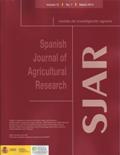Ver ítem
- xmlui.general.dspace_homeCentros Regionales y EEAsCentro Regional Buenos Aires NorteEEA San PedroArtículos científicosxmlui.ArtifactBrowser.ItemViewer.trail
- Inicio
- Centros Regionales y EEAs
- Centro Regional Buenos Aires Norte
- EEA San Pedro
- Artículos científicos
- Ver ítem
Organic production of leek (Allium porrum L.) seeds in the Northeast of the Province of Buenos Aires, 2: Phenology, yield and quality
Resumen
The aim of this work was to determine whether the local agroecological conditions of the northeast of the Province of Buenos Aires (33 deg 41 min S, 59 deg 41 min W) permit the organic production of leek (cv. Monstruoso de Carentan) seeds. In the 2000/01, 2001/02 and 2002/03 growth seasons, percentage flowering and seed yield (g m-2) and quality were recorded, the latter by determining the thousand grain weight and germination capacity. In the 2001/02 and
[ver mas...]
The aim of this work was to determine whether the local agroecological conditions of the northeast of the Province of Buenos Aires (33 deg 41 min S, 59 deg 41 min W) permit the organic production of leek (cv. Monstruoso de Carentan) seeds. In the 2000/01, 2001/02 and 2002/03 growth seasons, percentage flowering and seed yield (g m-2) and quality were recorded, the latter by determining the thousand grain weight and germination capacity. In the 2001/02 and 2002/3 seasons, the phenological stages of the crop were also determined, as well as the number of hours of cold temperatures experienced and the number of degree days. Significant differences between years were found in the number of days from 50% fruit setting to harvest, probably because three harvests were collected during the first season whereas only one was collected during the second and third. A total of 1,116 and 1,019 hours of cold temperatures and 925 and 1,127 degree days were recorded for 2001/2 and 2002/3 respectively. There were no significant differences between years for yield, percentage flowering or thousand seed weight (average values 78.53 gm-2, 93.36% and 3.55 g respectively). Differences in germination capacity were recorded, but Argentine legislative requirements were always surpassed. Seed yield and quality were comparable to figures cited in the literature. In conclusion, the agroecological conditions of the northeast of the Province of Buenos Aires allow the normal, organic cultivation of this leek cultivar for seed.
[Cerrar]
El objetivo de este estudio fue determinar si las condiciones agroecológicas locales (33º41’ L.S.; 59º 41’ L.O.) permiten satisfacer los requerimientos fisiológicos de la producción de semillas de puerro, cultivado según las normas de la agricultura orgánica. Durante las campañas 2000/01, 2001/02 y 2002/03 se determinaron los porcentajes de floración; los rendimientos de semillas en g m-2 y la calidad, a través del peso de mil semillas y la
[ver mas...]
El objetivo de este estudio fue determinar si las condiciones agroecológicas locales (33º41’ L.S.; 59º 41’ L.O.) permiten satisfacer los requerimientos fisiológicos de la producción de semillas de puerro, cultivado según las normas de la agricultura orgánica. Durante las campañas 2000/01, 2001/02 y 2002/03 se determinaron los porcentajes de floración; los rendimientos de semillas en g m-2 y la calidad, a través del peso de mil semillas y la germinación.
En las campañas 2001/02 y 2002/03 se determinaron las etapas fenológicas, las horas de frío y los días grado. No se
registraron diferencias estadísticas significativas (α = 0,05) entre años en la mayoría de las etapas fenológicas evaluadas. Existieron diferencias entre el 50% de cuaje y la cosecha, probablemente porque durante el primer año se realizaron tres cosechas, mientras que durante el segundo año se efectuó una sola. Se registraron 1.016 y 1.019 horas de frío y 925 y 1.127 días grado, durante las campañas 2001/02 y 2002/03, respectivamente. Los rendimientos (78,53 g m-2), porcentajes de floración (93,36%) y peso de semillas (3,55 g), no arrojaron diferencias estadísticas en tres años de medición. El poder germinativo tuvo diferencias entre años, aunque siempre superando los requerimientos de la legislación argentina. El rendimiento y la calidad de la semilla obtenidos son comparables a los citados en la bibliografía disponible. Las condiciones agroecológicas del noreste de Buenos Aires permiten el desarrollo normal del cultivo de puerro (cv. Monstruoso de Carentan) para la producción de semillas, cultivado según las normas de la agricultura orgánica.
[Cerrar]

Fuente
Spanish Journal of Agricultural Research 2 (4) : 564-569 (2004)
Fecha
2004
Editorial
Instituto Nacional de Investigación y Tecnología Agraria y Alimentaria, España
ISSN
2171-9292
Formato
pdf
Tipo de documento
artículo
Palabras Claves
Derechos de acceso
Abierto
 Excepto donde se diga explicitamente, este item se publica bajo la siguiente descripción: Creative Commons Attribution-NonCommercial-ShareAlike 2.5 Unported (CC BY-NC-SA 2.5)
Excepto donde se diga explicitamente, este item se publica bajo la siguiente descripción: Creative Commons Attribution-NonCommercial-ShareAlike 2.5 Unported (CC BY-NC-SA 2.5)


